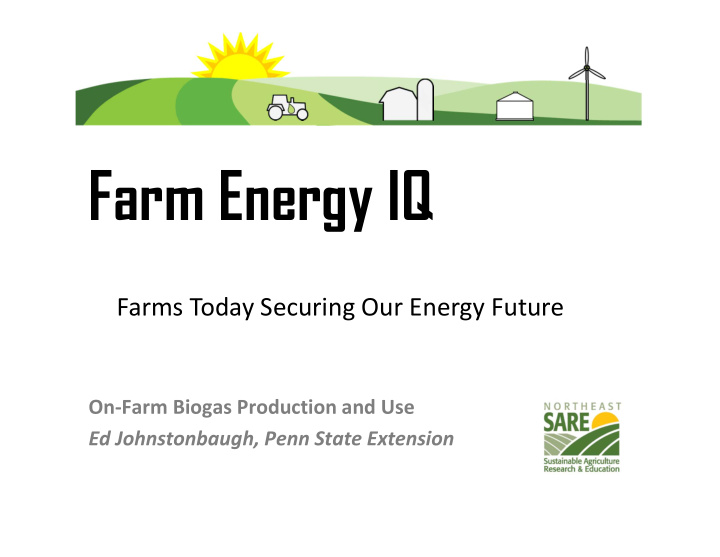



Farm Energy IQ Farms Today Securing Our Energy Future On ‐ Farm Biogas Production and Use Ed Johnstonbaugh, Penn State Extension
Farm Energy IQ On-Farm Biogas Production and Use Ed Johnsonbaugh, Penn State Extension
What Y ou’ll Learn • How organic feedstock is converted to useful energy • The technologies and how they work • What operating systems look like • How much organic material is needed per unit of energy • Best practices for using biologically ‐ derived methane • How to calculate useful energy production • Safety concerns
What’s the Technology? Anaerobic digestion • Organic matter in airtight, oxygen ‐ free enclosure • Without oxygen, organisms digest organic matter and produce methane In a biodigester • Organic matter in slurry—such as liquid manure and finely chopped vegetable matter—is injected • Small particles are more Graphic credit: Afrisol Energy LTD. (Afrisolenergy.com ) accessible to the bacterial microbes to consume
Slide 4 JS2 I suggest trying to find a more relevant graphic that reflects U.S. nomenclature (e.g., "manure instead of dung" and our typical use of biogas (electrical generation, not cooking and lighting) Jeannie Sikora, 12/6/2014
Converting Organic Matter to Methane Organic matter includes low ‐ value biodegradable material that would otherwise require sustainable disposal Typical feedstock includes: 1. Liquid livestock manure 2. Manufacturing waste products like whey, potato peels, fruit skins, husks, hulls and vegetable food scraps.
How does a digester function? Methane gas outlet Feedstock enters the system Feedstock combines in the digestion tank Solids and water exit the Gas is collected in the dome system Illustration credit: En.wikipedia.org
Keeping a Digester “Healthy” • An oxygen free environment • Fresh liquefied feedstock injected twice a day with minimal, if any, solids and no non ‐ organic contaminants • Maintain temperature between 95°F to 100°F (35°C to 38°C) • A pH balanced between 6.6 and 7.6
The Right Balance of Bacteria Image credit: Anaerobic Digestion: Biogas Production and Odor Reduction from Manure. Penn State Cooperative Extension Fact sheet G77.
Biogas Composition • CH 4 ‐ methane ‐ 550 to 700 Btu/ft 3 (2.05 x 10 7 to 2.61 x 10 7 Joule/m 3 ) • CO 2 ‐ carbon dioxide • H 2 S ‐ hydrogen sulfide
Digester Size Image credit: Anaerobic Digestion: Biogas Production and Odor Reduction from Manure. Penn State Cooperative Extension Fact sheet G77.
Sizing Considerations • Manure from a typical 1,400 lb. cow produces about 4 kWh/day of electricity • 4 kWh/day ≈ 1,460 kWh/yr • 1,460 kWh is worth about $146 • Generator sizing – Divide 1,460 kWh/cow/yr by 8760 hours/yr to determine electric power output ( ≈ 0.17 kW/cow/yr) – Generator will also produce waste heat to temper feed ‐ water or for cleaning
Sizing Considerations • Supplying enough methane gas to power a 20 kW generator, given 0.17 kW per cow production rate, requires approximately 120 cows • Cow manure is not the richest manure in terms of power output because cows efficiently digest much of the energy contained in their feed
Sizing Considerations • Biogas produced from dairy manure is typically about 60% methane • As a result, the methane proportion of the dairy cow biogas may not be sufficient to operate a generator at full load
Sizing Considerations • To boost methane content, one dairyman we know adds whey from a nearby cheese operation and distiller’s wet grain solubles (DWGS) to the dairy manure • These enrichments increase the methane content in the biogas to enable operating a generator at full load throughout the year
That 20 kW Electric Generator… • Will produce 150,000 kWh/Yr. (+ or ‐ )* • Will offset about $15,000 per year in electric costs • Will produce waste heat to maintain digester operating temperature during cold weather • Remaining excess heat goes to a radiator or can be used to preheat cleaning water *Assumes an 85% reliability factor, electricity priced at $0.10/kWh
Comparing energy in other waste
Linear Plug Flow Biodigester Source: http://www.climatetechwiki.org/technology/jiqweb ‐ anbt Source: http://enermac.com/Strabab ‐ SEHL.htm
Round Plug Flow Biodigester Brookside Dairy Biodigester
Slide 18 JS4 Photo source? Location of digester?If unknown, suggest removing "Brookside Dairy" since it leaves us guessing. Jeannie Sikora, 12/6/2014
Fixed Dome Biodigester Source: http://biogas ‐ technology.blogspot.com/2013_06_01_archive.html Source: http://www.appropedia.org/Fixed_dome_digester
Internal Combustion Engines Modified diesel generator with thermal recovery for process heat Photo credit: Ed Johnstonbaugh, PSU Extension
Methane Safety Concerns The production of methane gas presents asphyxiation, fire, and explosion hazards 1. Never enter a closed area where methane may be present without an appropriate breathing apparatus 2. Keep open flames and sparks away from methane production and storage areas 3. Follow code for any given application 4. Treat methane gas with the same safety precautions as natural gas—they are one and the same 5. Adhere to National Electric Code standards for wiring requirements in settings containing natural gas
Electrical Safety Concerns 1. Consult your local electrical provider for regulations concerning grid interconnection and operation of customer ‐ owned electrical generation facilities 2. Contract the services of a qualified electrical contractor to design and install electrical equipment 3. Never operate equipment outside of its design parameters 4. Employ a routine maintenance schedule to keep equipment in top condition 5. Have any changes, additions, or deletions inspected by a qualified electrical inspector
Farm Energy IQ On-Farm Biogas Production and Use Questions?
Recommend
More recommend